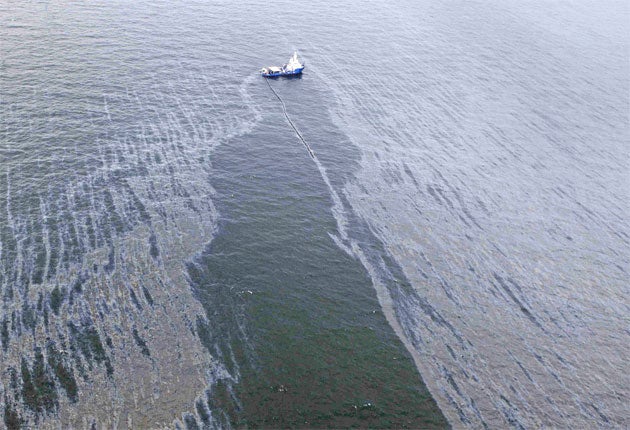You won't see him covered in soot and tar, attempting hand-to-hand combat with the oil gushing into the Gulf of Mexico. And unlike his late colleague and mentor, Paul "Red" Adair, he doesn't even have a nickname. But Pat Campbell, the man BP has employed to cap the well beneath the ruined Deepwater Horizon oil rig, does at least know how to talk the talk.
"Oh, we'll kill that well," he told reporters this week, adding that the source of what will soon become the oil industry's worst-ever natural disaster merely needs to be shown who's boss. "I'm here, I'm touching you, I'm telling you you're dead," was how he described the process of shutting it down. "You just don't know it yet."
Today, Campbell will mastermind BP's latest attempt to plug the hole that is currently firing a pressurised stream of at least 5,000 barrels of oil per day, into the ocean. It's called a "top kill" and will see a stream of heavy mud pumped into the well, followed by a large dollop of quick-drying cement. At some point during the process, he explained, they may also try a "junk shot". That will see a massive ball of rubbish, including old golf balls, shredded car tyres, and a vast amount of human hair, fired at the well in an attempt to further interrupt the flow.
It's a dirty-sounding job. But unlike his swashbuckling predecessors, Campbell is unable to get within touching distance of the blown-out well he hopes to tame, since it sits roughly 5,000 feet below the surface of the ocean, where it is accessible only via deepwater robots.
Instead, he will mastermind proceedings from BP's air-conditioned command centre several thousand miles away in Houston, Texas, where he found time on Monday to tell reporters about his life and times, together with how he plans to bridge gaps in the well's "blowout preventer," the piece of safety equipment which failed so devastatingly on 20 April.
In an interview with The New York Times, Campbell said he was proud of his team's "absolutely marvellous" preparations, but "frustrated" that the location of the operation meant he couldn't watch it in person. Instead, he will control proceedings using a network of waterproof video cameras.
If today's effort doesn't work, further top kill attempts will be made, and more junk shots fired in the coming days and weeks. As a last resort, relief wells are currently being drilled, which are supposedly guaranteed to cut off the flow by mid-August.
By that time, the damage done to the Gulf of Mexico, not to mention the future of BP, would be scarcely imaginable. But Campbell, 65, who has spent four decades in the business, has grown used to working under the shadow of an unfolding, apocalyptic crisis.
He cut his teeth working for Red Adair during the 1960s, when his mentor's exploits were chronicled in the John Wayne film Hellfighters, working in a factory in California which made equipment used for fighting blowouts.
When Adair and his partners Asger Hansen, known as Boots, and Ed Matthews, or Coots, went off on a job, Campbell was usually invited to join them. "They'd say, 'Hey, fat boy, why don't you just come along with that stuff and make sure it works?'," he recalled.
In the 1970s, Hansen and Matthews split from Red Adair, and formed their own firm, Boots & Coots, taking Campbell with them as general manager. In the 1990s, when he had become one of the leading experts in the field, he was sent to Kuwait to deal with the oil wells Saddam Hussein's troops destroyed in the aftermath of the first Gulf War.
They originally estimated that 200 wells would need capping. By the time they arrived in the desert, 900 were ablaze. "We really thought, he'll blow up a couple of wells and say, 'I mean business now'," Campbell said. "We were all watching CNN just as everybody else was. We could absolutely not believe it."
Putting out those fires took several months, but although the job made for dramatic pictures, it was not quite as dirty as it might have seemed, he added. "It's black, there's lots of black soot," he said. "It looked terrible. But generally, not being dummies, you go to the upwind side and you work in the clean air."
These days, Campbell says that disaster relief has become a more collegiate affair. He also told The New York Times that helping BP cap Deepwater Horizon involves dealing with meddling managers and politicians. "Today things are done by committees. The executive management gets involved. They may or may not have any technical competence." That can make things complicated, he said, but "it generally works out fine".

Join our commenting forum
Join thought-provoking conversations, follow other Independent readers and see their replies
Comments